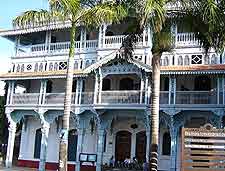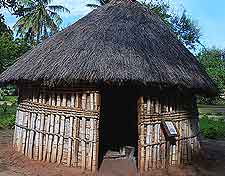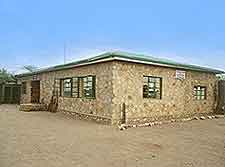Tanzania Museums
(Tanzania, TZ, East Africa)

Many of Tanzania's museums offer a great insight into the traditions and cultures of local people. Some use 'living history' methods to vividly bring to life the sorts of lives that tribes such as the Maasai continue to lead.
The largest in Tanzania is the National Museum in
Dar es Salaam. Here, the famous Leakey digs of the 1970s, which went in search of prehistoric human remains, feature widely. Other more than noteworthy cultural offerings await visitors in Arusha, Butiama, Mwanza and within the Ngorongoro Conservation Area.
National Museum and House of Culture
Address: Shaabaan Robert Street, Dar es Salaam, Tanzania, TZ, Africa
Tel: +255 022 211 7508
This recently renamed and renovated attraction was originally known as the King George V Museum. It originally opened in 1940 and since then has managed to build up an impressive collection of Tanzanian-related exhibits, most notably fossils of early humans collected during the Leakey digs. The National Museum and House of Culture is also a good place to begin if you're interested in Tanzanian history in general. Exhibit concentrate on the history of slavery in the country, as well as local traditions and events during Tanzania's colonial period. A contemporary art gallery is a recent addition to the museum.
Open hours: 09:30 to 18:00
Admission: charge, discounts available for students and children

Village Museum
Address: Makaburi Street / New Bagamoyo Road, Dar es Salaam, Tanzania, TZ, Africa
Tel: +255 022 270 0437
Tanzanian history is brought to life at the open-air Village Museum, located roughly 10 km / 6 miles from the centre of Dar es Salaam. The emphasis is on showing traditional rural practices and authentic homesteads. Villagers are on hand to demonstrate handweaving, carving and other age-old handicrafts, while dance performances are also held during the afternoons.
Open hours: daily - 09:30 to 18:00
Admission: charge, discounts available for students and children
Maasai Cultural Museum
Address: Meserani Snake Park, Arusha, Tanzania, TZ, Africa
Visitors can enjoy a guided tour of this small museum in the company of an actual Maasai warrior, who is on hand to explain the traditions and cultural practices of this well-known East African tribe. Proceeds from this attraction go towards funding a free medical clinic for local people, which is also situated within the grounds of the
Meserani Snake Park. Expect lots of dioramas, brought to life by background noises, chanting and singing.
Open hours: daily
Admission: charge
Natural History Museum
Address: Boma Road, Arusha, Tanzania, TZ, Africa
Tel: +255 027 2507540
Arusha's Natural History Museum is housed in three buildings within the town's old German fort, named the 'Boma'. In 1934, it was transformed into a museum of natural history. The main focus is on the evolution of early mankind, particularly the discovery of fossils found within the Olduvai Gorge. The prize exhibit on display is undoubtedly the trail of footprints known as the Laetoli Footprints, which were discovered in 1978. Also of interest are the various plant and insect exhibits, as well as those recounting Tanzania's colonial history and its struggle for independence.
Open hours: daily
Admission: charge

Olduvai Gorge Museum
Address: Ngorongoro Conservation Area, Tanzania, TZ, Africa
Founded by Mary Leakey in the late 1970s, Olduvai Gorge Museum is now looked after by Tanzania's Department of Cultural Antiquities. The attraction was created to house fossils of early hominids, as well as tools and other paleontological artefacts found in the area around Olduvai Gorge. In the 1990s it was restored and a new wing added using funding from the J. Paul Getty Museum.
Open hours: daily
Admission: charge
Mwalimu Nyerere Museum Centre
Address: Butiama, Tanzania, TZ, Africa
Tel: +255 028 2621338
The Mwalimu Nyerere Museum Centre first opened its doors to visitors in 1999. Exhibits include an interesting selection of objects relating to the life of Mwalimu Julius Nyerere, who was born in this village in 1922 and later became the country's very first president. They include personal items, as well as those involved in the struggle for Tanzania's independence and some presidential gifts.
Open hours: daily - 09:30 to 18:00
Admission: charge
Sukuma Museum
Address: Bujora Paris, Mwanza, Tanzania, TZ, Africa
The Sukuma tribe are one of the largest in Tanzania. This venue was set up as a community initiative to preserve the tribe's tradition arts and culture in the form of 'living history'. The museum, which was set up in the late 1960s by the late Father David Clement, welcomes around 2,000 visitors each year. Within the grounds are examples of traditional Sukuma buildings, including a Royal Pavilion and Dance Pavilion. Exhibits on display include drums, costumes, furniture and weapons.
Open hours: daily
Admission: charge
Arusha Declaration Museum
Address: Makongoro Road, Arusha, Tanzania, TZ, Africa
Tel: +255 027 2507800
This attraction started out life as the social welfare hall for those living in the Kaloleni area of Arusha. It was here that, in 1967, the Arusha Declaration was adopted by the ruling Tanganyika African National Union. By 1977, the building had been converted into a political museum. Permanent exhibitions relate the history of Tanzania from pre-colonial times to the present day, including the struggle for independence. Temporary exhibitions are held regularly. Also onsite is a small art gallery displaying works created by local artists.
Open hours: daily - 09:00 to 17:00
Admission: charge
Tanzanite Museum
Address: Blue Plaza Building, Arusha, Tanzania, TZ, Africa
Arusha's Tanzanite Museum is devoted to a blue-purple mineral which was first discovered in the Mererani Hills of northern Tanzania in the late 1960s. Tanzanite today commands prices that are reputed to be higher even than gold. This attraction is run by the Arusha Tanzania Tanzanite Foundation and has an auditorium where visitors can watch video screenings on the history of the precious mineral and local geology. There are also displays of gems in both their rough and cut state, as well as items manufactured using Tanzanite.
Open hours: daily
Admission: charge
 Many of Tanzania's museums offer a great insight into the traditions and cultures of local people. Some use 'living history' methods to vividly bring to life the sorts of lives that tribes such as the Maasai continue to lead.
Many of Tanzania's museums offer a great insight into the traditions and cultures of local people. Some use 'living history' methods to vividly bring to life the sorts of lives that tribes such as the Maasai continue to lead.
